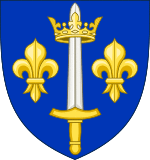A Child's History of England.112
From the moment of her capture, neither the French King nor one single man in all his court raised a finger to save her. It is no defence of them that they may have never really believed in her, or that they may have won her victories by their skill and bravery. The more they pretended to believe in her, the more they had caused her to believe in herself; and she had ever been true to them, ever brave, ever nobly devoted. But, it is no wonder, that they, who were in all things false to themselves, false to one another, false to their country, false to Heaven, false to Earth, should be monsters of ingratitude [忘恩负义] and treachery to a helpless peasant girl.
In the picturesque [风景如画的] old town of Rouen, where weeds and grass grow high on the cathedral towers, and the venerable Norman streets are still warm in the blessed sunlight though the monkish fires that once gleamed [闪露] horribly upon them have long grown cold, there is a statue of Joan of Arc, in the scene of her last agony, the square to which she has given its present name. I know some statues of modern times - even in the World's metropolis, I think - which commemorate [纪念] less constancy [坚定忠诚], less earnestness [严肃诚挚], smaller claims upon the world's attention, and much greater impostors [冒名顶替].
Joan of Arc did not come from a place called Arc. In the English language her first name has been repeated as Joan since the fifteenth century because that was the only English equivalent for the feminine form of John during her lifetime. Her surviving signatures are all spelled Jehanne without surname. In French her name is today always rendered as Jeanne d'Arc /ʒandaʁk/, reflecting the modern spelling of her first name. The surname of Arc is a translation of d'Arc, which itself is a nineteenth-century French approximation of her father's name. She was born to Jacques d'Arc and Isabelle Romée, a peasant family, at Domrémy in the Vosges of northeast France.
Joan of Arc (c. [circa,约] 1412 - 30 May 1431). On 23 May 1430, she was captured at Compiègne by the Burgundian faction, a group of French nobles allied with the English. She was later handed over to the English and put on trial by the pro-English bishop Pierre Cauchon on a variety of charges. After Cauchon declared her guilty, she was burned at the stake on 30 May 1431, dying at about nineteen years of age.
In 1456, an inquisitorial court authorized by Pope Callixtus III examined the trial, debunked the charges against her, pronounced her innocent, and declared her a martyr. In the 16th century she became a symbol of the Catholic League, and in 1803 she was declared a national symbol of France by the decision of Napoleon Bonaparte.
六级/考研单词: fingerprint, noble, devote, monster, peasant, weed, cathedral, gleam, statue, arc, agony, commemorate, earnest, equivalent, feminine, surname, render, translate, faction, bishop, guilt, authorize, pronounce, innocent, martyr, catholic, nationwide
Coat of arms of Joan of Arc; her signature; siege of Orleans








 浙公网安备 33010602011771号
浙公网安备 33010602011771号